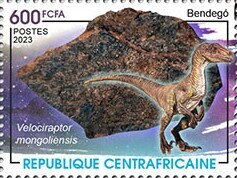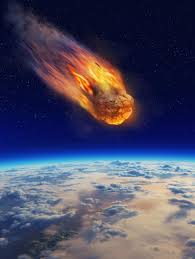Stamp: Bendegó, Velociraptor mongoliensis (Central African Republic 2023)
Bendegó, Velociraptor mongoliensis (Central African Republic 2023)
15 September (Central African Republic ) within release Meteorites (2023) goes into circulation Stamp Bendegó, Velociraptor mongoliensis face value 600 Central African CFA franc
| Stamp Bendegó, Velociraptor mongoliensis in catalogues | |
|---|---|
| Yvert et Tellier: | Yt: CF 11318 |
Stamp is square format.
Also in the issue Meteorites (2023):
- Mini Sheet - Meteorites and Dinosaurs face value 6*600;
- Souvenir Sheet - Yamato 000593 and Ceratops horridus face value 3,600;
- Stamp - Arroyo Aguiar face value 600;
- Stamp - Bendegó, Velociraptor mongoliensis face value 600;
- Stamp - Huckitta, Pteranodon longiceps face value 600;
- Stamp - Northwest Africa 801 face value 600;
- Stamp - Old Woman, Agathaumas sylvestris face value 600;
- Stamp - The Eagle, Dimetrodon limbatus face value 600;
Stamp Bendegó, Velociraptor mongoliensis it reflects the thematic directions:
Animals are multicellular, eukaryotic organisms of the kingdom Animalia (also called Metazoa). All animals are motile, meaning they can move spontaneously and independently, at some point in their lives. Their body plan eventually becomes fixed as they develop, although some undergo a process of metamorphosis later on in their lives. All animals are heterotrophs: they must ingest other organisms or their products for sustenance.
Dinosaurs are a diverse group of reptiles of the clade Dinosauria. They first appeared during the Triassic period, between 243 and 233.23 million years ago (mya), although the exact origin and timing of the evolution of dinosaurs is a subject of active research. They became the dominant terrestrial vertebrates after the Triassic–Jurassic extinction event 201.3 mya and their dominance continued throughout the Jurassic and Cretaceous periods. The fossil record shows that birds are feathered dinosaurs, having evolved from earlier theropods during the Late Jurassic epoch, and are the only dinosaur lineage known to have survived the Cretaceous–Paleogene extinction event approximately 66 mya. Dinosaurs can therefore be divided into avian dinosaurs—birds—and the extinct non-avian dinosaurs, which are all dinosaurs other than birds.
A meteorite is a rock that originated in outer space and has fallen to the surface of a planet or moon. When the original object enters the atmosphere, various factors such as friction, pressure, and chemical interactions with the atmospheric gases cause it to heat up and radiate energy. It then becomes a meteor and forms a fireball, also known as a shooting star; astronomers call the brightest examples "bolides". Once it settles on the larger body's surface, the meteor becomes a meteorite. Meteorites vary greatly in size. For geologists, a bolide is a meteorite large enough to create an impact crater.



